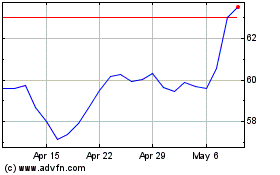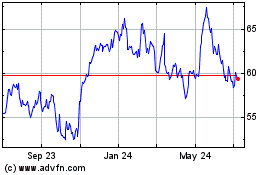By Nina Trentmann
After a year of deal-making and deal-avoiding -- including seven
acquisitions and the rejection of takeover bids -- executives at
Smurfit Kappa Group PLC thought it would be good to gauge how well
they had communicated the company's strategy and its story along
the way.
The Dublin-based company commissioned an investor-perception
study from consulting firm Rivel Research Group, which polled
dozens of shareholders and analysts. The results were an eye-opener
for executives, who had assumed Smurfit Kappa -- Europe's largest
producer of paper-based packaging -- would be viewed as focused on
growth.
"People thought of us as a leveraged vehicle and felt that our
approach was much more about debt reduction than about investing,"
said Ken Bowles, Smurfit Kappa's chief financial officer. "It
didn't fit with where we were and what we were doing."
The company pored over its corporate communications -- annual
reports, presentations, news releases, earnings-call transcripts --
and realized that executives' talk of efforts to reduce the
company's EUR3.1 billion ($3.4 billion) debt pile at the end of
2018 was what actually resonated with the outside world. Not the
acquisitions.
"We misfired with our communications," Mr. Bowles said. The
company has since revised its corporate literature to address the
mismatch and now chooses its words more carefully, highlighting its
focus on sustainable growth instead, he said.
Smurfit Kappa is part of a growing group of companies turning to
external assessments to fine-tune their communications. The target
audience isn't just human analysts and investors: Machine-learning
tools, perception studies and speech recognition are also used by
finance and investor-relations executives seeking to anticipate the
reaction of robots that increasingly sway the market by buying and
selling shares on the basis of data analysis.
Meanwhile, campaigning from activist investors, a stronger focus
on environmental, social and corporate governance and changes to
financial regulation also add to the need to get the message
across.
"We really have to change the way we are writing and scripting,"
said Hala Elsherbini, senior vice president at Halliburton Investor
Relations & Communications, a Richardson, Texas-based investor
relations and communications agency unrelated to oil-field services
company Halliburton Co.
These days, a lot of investors are using language- and
sentiment-analysis tools, which means companies have to adjust how
they talk about their finances, said Ms. Elsherbini, who said she
is working with about 20 U.S.-based companies to help them
communicate more effectively.
Algorithmic traders using sentiment analysis -- an automated
process that identifies positive, negative and neutral opinions in
a body of text -- can react negatively to wording such as "contrary
to," Ms. Elsherbini said, adding that she prefers the more
positive-sounding "different to" when drafting a company release or
an earnings call script. Similarly, she avoids frequent use of
terms like "shortfall" or "decline" and focuses on just numbers
instead.
"Don't overstate the negative," she said.
Other companies are pitching data-crunching software tools that
they say can find signals in companies' public statements.
Prattle, a St. Louis-based text analytics company, uses machine
learning and natural language processing to create a lexicon of a
company's commonly used words. This can help institutional
investors get a better understanding of a company's tone and the
potential implications.
Most of Prattle's revenue comes from quantitative hedge funds
that subscribe to its services, said Chief Executive Evan
Schnidman. The company -- which was founded in 2014 and acquired
this year by investment network Liquidnet Holdings Inc. -- also has
a tool that corporate investor-relations teams can use to test the
potential market impact of their company's language, he said.
Rival software firm Amenity Analytics, based in New York, has
come up with a "deception score" tool that warns investors when
companies may be using evasive language, euphemisms or stalling
tactics, according to CEO Nathaniel Storch. "As an investor, you
are always trying to understand something that other people are
missing," said Mr. Storch, whose company has more than doubled its
customer count over the past year, according to a spokeswoman.
Big companies aren't all using these technologies to improve
their communications. Brewing giant Anheuser-Busch InBev SA, for
instance, recently gathered information on language-recognition
technology to get a better understanding of what is possible, but
so far isn't using it, said Lauren Abbott, global vice president
for investor relations at AB InBev.
Still, AB InBev over the past year has adjusted its
communication strategy following an investor-perception study
similar to the one commissioned by Smurfit Kappa. The company now
focuses on more face-to-face interactions between executives and
investors and uses its earnings release to provide a more strategic
update instead of regurgitating numbers, Ms. Abbott said.
Brian Rivel, chairman and CEO of Rivel Research, which conducts
nearly 170 investor perception surveys a year, said the firm's
revenue from that part of its business has roughly doubled to $8
million this year from $4 million in 2009. Behind the increased
interest, he said, is his clients' belief that calibrating their
communications can boost their shares.
"There are two things that motivate people: fear of activism,
and opportunism," Mr. Rivel said. "CEOs want their companies to
have a higher stock price."
Write to Nina Trentmann at Nina.Trentmann@wsj.com
(END) Dow Jones Newswires
November 19, 2019 15:11 ET (20:11 GMT)
Copyright (c) 2019 Dow Jones & Company, Inc.
Anheuser Busch Inbev SA NV (NYSE:BUD)
Historical Stock Chart
From Mar 2024 to Apr 2024

Anheuser Busch Inbev SA NV (NYSE:BUD)
Historical Stock Chart
From Apr 2023 to Apr 2024
